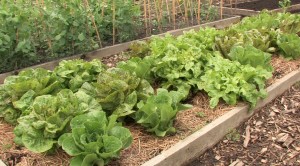Tip of the Week: The Lives of Lettuces
Posted in Gardening Tips on August 31 2009, by Sonia Uyterhoeven
 |
Sonia Uyterhoeven is Gardener for Public Education. Join her each weekend for home gardening demonstrations on a variety of topics in the Home Gardening Center. |
 The lettuce that we find on our dinner tables, Lactuca sativa, differs greatly from its early progenitor found in ancient Egypt. The Egyptians dined on a plant that was similar to the weedy, prickly lettuce Lactuca serriola, which is very bitter and was blanched (grown in darkness) for a period of time to make it more palatable.
The lettuce that we find on our dinner tables, Lactuca sativa, differs greatly from its early progenitor found in ancient Egypt. The Egyptians dined on a plant that was similar to the weedy, prickly lettuce Lactuca serriola, which is very bitter and was blanched (grown in darkness) for a period of time to make it more palatable.
The bitterness comes from a latex or milky juice that is prominent in all lettuces when they mature and go to seed. This feature is denoted in both its Latin and common names. The Latin name, Lactuca sativa, translates into milky plant (Lactuca) grown from seed (sativa). The common name, lettuce, is derived from an old French word that means milky (laitues).
Lettuce is in the Asteraceae family. If you let it bolt (i.e. go to seed), you will be able to quickly identify its family of origin. The flowers have a distinctive daisy-like appearance and look like small dandelions.
There are many different kinds of lettuce. They are usually classified in the following main groups: Romaine (Cos), Butterhead, Crisphead, and Looseleaf.
Romaine or Cos lettuce was thought to have originated from Southern Europe (Greece and Italy). It is an upright plant with elongated leaves. It has a crunchy texture and sturdy leaves. Due to its warmer origins, romaine lettuce tends to be more heat tolerant than most other types. An interesting heirloom variety to try is the speckled ‘Forellenschluss’.
Butterhead forms a nice compact head with soft, buttery foliage. It is best when harvested young. ‘Boston’ and ‘Buttercrunch’ are two well-known green varieties, but heirloom catalogs boast a host of red-leaved cultivars that are superb such as ‘Pirat’.
Crisphead lettuce includes iceberg and summer crisp or Batavian lettuce. Summer crisps are similar to icebergs except that the heads are not as tight, the leaves are often wavy, and they are easier to grow than iceberg lettuce. A classic is a French heirloom named ‘Queen of the Ices’ or ‘Reine des Glaces’. I have grown this before and it is a beauty.
Iceberg lettuce, due to its popularity, has turned into a category of its own, but originally it was a cultivar introduce into the market in 1894 by the Burpee Seed Company. ‘New York Head’ is a variety that forms an almost solid head and ‘Red Iceberg’ is an unusual treat.
Looseleaf lettuces are by far the easiest and most popular lettuces for home gardeners to grow. These lettuces don’t form a head and can be harvested either as a full plant or from individual leaves in a cut-and-come style of production.
The ever popular mesclun is a mixture of primarily looseleaf lettuce that is sown densely just as you would seed a lawn. They are generally harvested when 4–5 inches tall. Cut them down to about an inch above the ground and in 2–3 weeks you will be able to come back and cut them again. They can be cut back from two to four times before the plants suffer from exhaustion. Some people plant their mesclun in strips so that they harvest a strip or lane a day. By the time they have reached the seventh or tenth lane, they are almost ready to start harvesting again.
You will know from experience that lettuce doesn’t store particularly well. This is due to its high water content. Most lettuces will begin to wilt after several days in the refrigerator. The best way to store lettuce is to wash it, wrap it in a paper towel and store it in a plastic storage bag.
The best time to harvest lettuce is in the morning when it is still nice and fresh, before it has been beaten down by the heat of the day. I recently heard a grower explain that vegetables are best harvested in the morning when it is cool because they collapse in the heat of the day just like we do. How true.

